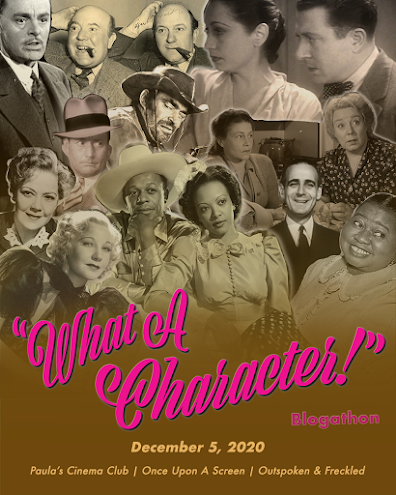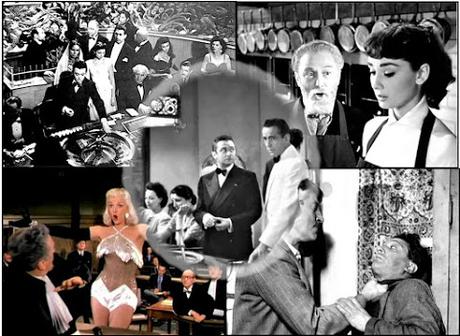
This is my entry for the annual What a Character! blogathon hosted by Paula at Paula's Cinema Club, Aurora of Once Upon a Screen and Kellee at Outspoken & Freckled.
~
I was watching Josef von Sternberg’s flamboyantly decadent noir The Shanghai Gesture(1941) a while ago. Taking in the dense and elaborate décor, sinister atmosphere and louche characters the maestro whipped together for this wickedly twisted cinematic excursion, I marveled that the censors had left so much intact. The setting is a palatial Shanghai gaming house, a den of iniquity if there ever was one, with vice of every kind lurking in its shadowed nooks.
As I watched, I noticed a croupier at the center of the casino’s terraced gambling pit. For just a moment I went blank and thought I must be watching another film. A completely different film. One of the most celebrated of Hollywood films and possibly the greatest, Casablanca (1942), for this man was surely Emil, the croupier at Rick’s in French Morocco.
But this croupier was not Emil. This man was credited as “The Master of the Spinning Wheel” at Madame Gin-Sling’s Shanghai gambling den. Maybe so but it was plain that both croupiers were portrayed by one and the same actor.
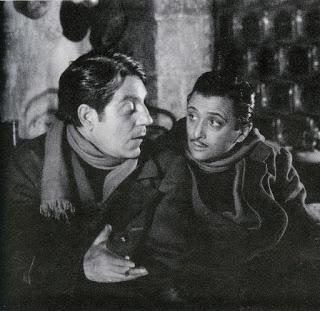
Jean Gabin and Dalio in Renoir's Grand Illusion (1937)
In Grand Illusion, Renoir’s anti-war masterpiece set during World War I, Dalio portrayed Rosenthal, a prisoner of war from a wealthy French Jewish banking family. An expansive character, Rosenthal was proud of his family and its accomplishments and generous with his fellow prisoners. The Rules of the Game, Renoir’s other equally venerated classic, offers a jet black satire on social “rules.” As Robert de la Chesnaye, Dalio portrayed a French aristocrat with a penchant for mechanical playthings. In one scene Dalio’s character shows off his latest joy, a glittering calliope with, literally, lots of bells and whistles. As Roger Ebert retells it, Renoir needed a specific facial expression from the actor in this scene, one that implied pride along with embarrassment for feeling so proud, and delight with some shyness for revealing such delight. Renoir would say that what he got from Dalio may have been the best shot he ever filmed.
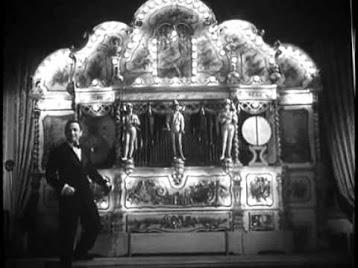
Dalio with calliope in Renoir's The Rules of the Game (1939)
When the German Army occupied Paris in June of 1940, Marcel Dalio and his young wife, actress Madeleine Lebeau, had just left the city and were on their way across southern Europe and on to South America, then to Mexico. In Mexico they learned that the visas they had paid for were forgeries but they eventually managed to obtain temporary Canadian passports. From there the couple was able to enter the United States.With the help of friends in the industry who had preceded them to the U.S. – among them Charles Boyer, Rene Clair, Jean Renoir and Julien Duvivier - they would finally come to Hollywood.
~
Marcel Dalio was born Israel Moshe Blauschild, of Romanian Jewish descent, in Paris on July 17, 1900. He trained as an actor at the Paris Conservatoire and in 1920 began performing in the theater. His film career began in the '30s.Of his choice of stage names, Dalio would later recall:
“Marcel de Blancheville or Marc de Beauchili? On the eve of leaving for the first time on tour with a company of actors I had to choose a name for myself. Something properly French, also a bit grandiloquent, and naturally aristocratic. Because there was no question of appearing on the poster under my real name: Israël Mosche Blauschild! It was enough to make the brave Swiss for whom we were to perform flee! ‘Blancheville or Beauchili? My decision was made: neither one nor the other...I had my idea. I was still dazzled by the memory of the handsome prince Danilo in The Merry Widow and a name formed itself in my head: Dalino...Dalo...DALIO !!! I was baptized.”
Dalio’s film career reached a high point with the release of The Rules of the Game in July 1939, but within two months World War II would explode across Europe. Dalio made two more films before fleeing Paris with his wife at the last minute. Although Dalio was no longer in France, his films were. Apparently his appearance – and perhaps the fact that he had successfully evaded the Nazis – offended the new collaborationist Vichy government because publicity stills of him were chosen for use on posters to be displayed all over Paris. The intention was to illustrate what "a typical Jew" looked like so citizens could more easily identify and report suspected Jews to the authorities. In addition, in 1944 when his 1938 film Entrée des artistes was to be re-released, all of Dalio’s scenes were reshot with a non-Jewish actor.
~
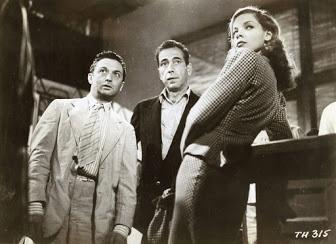
Dalio with Bogie & Bacall in To Have and Have Not (1944)
Both Dalio and his wife, Madeleine Lebeau, had roles in Casablanca, with Madeleine in the memorable part of Yvonne, Rick’s sometimes unruly ex-girlfriend. By the time the picture was in production, the couple was about to divorce, but they would both appear in the French Resistance drama Paris After Dark the following year. Among Dalio’s other wartime Hollywood film roles were the part of a French policeman in The Song of Bernadette (1943), French Premier Georges Clemenceau in the Oscar-winning biopic Wilson (1944), and, later the same year, Gerard/aka Frenchy, owner of the Martinique hotel where To Have and Have Not is set. Though his filmography in France had included a spectrum of characters from the treacherous to the congenial, once in Hollywood, Dalio quickly – and not very surprisingly for the time and the world situation - became typed. It’s fair to say that the nickname of his character in To Have and Have Not – “Frenchy” – could generally apply to many of his roles in American films, even those with names like “Luigi” and “Vladimir.”
When World War II ended, Dalio returned to Paris and making films in France for a while. In the 1950s he worked mostly in Hollywood, first appearing in the Danny Kaye vehicle On the Riviera (1951), a musical comedy. In The Snows of Kilimanjaro (1952), Dalio portrayed Emile, owner of Emile’s nightclub in Paris. (Did adding an “e” to Emil help him advance to a position comparable to Rick’s in Casablanca?) It was an adaptation of a Hemingway story starring Gregory Peck, Susan Hayward and Ava Gardner. Dalio was cast in the bit part of an exasperated Parisian magistrate in Gentlemen Prefer Blondes (1953), the runaway hit that made a star of Marilyn Monroe, and that same year he played fellow cooking class student Baron St. Fontanel alongside Audrey Hepburn in Billy Wilder’s Sabrina.
Dalio would also have small parts in the 1957 version of The Sun Also Rises, with its all-star cast top-lined by Ava Gardner, Errol Flynn and Tyrone Power, and in 1959's Pillow Talk, the first of the classic Doris Day/Rock Hudson romcoms. From the mid- to late-‘50s he also worked regularly on American television in classic series like Alfred Hitchcock Presents, Peter Gunn, Maverick, One Step Beyond, Playhouse 90, Death Valley Days, 77 Sunset Strip, Adventures in Paradise and Ben Casey.
Dalio turned 60 in 1960. His American films of that decade brought more small roles in films like The Devil at 4 O’Clock (1961) an adventure/drama set in Hawaii starring Frank Sinatra and Spencer Tracy; The List of Adrian Messenger (1963) a mystery/thriller packed with top leading men of the time including Kirk Douglas, Burt Lancaster, Robert Mitchum and Frank Sinatra; the 1965 comedy Lady L (1965) with Sophia Loren, Paul Newman, David Niven and Dalio heading the cast in that order; and William Wyler’s comedy caper How to Steal a Million (1966) starring Audrey Hepburn and Peter O’Toole. Mike Nichols’ Catch-22 (1970) gave Dalio a moment to shine in his role as a extremely “Old Man” opposite Art Garfunkle’s innocent young soldier. His final role in the U.S. was as a French fight promoter in The Great White Hope (1970) starring James Earl Jones, a film based on the life of boxer Jack Johnson. The remainder of Dalio’s career would take place in Europe.
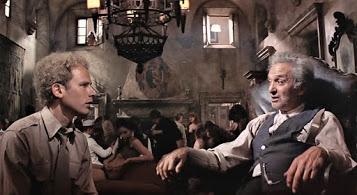
Catch-22 (1970), Art Garfunkle and "107-year-old" Dalio
His film career in France was derailed for years because of the war. In Hollywood he was almost always cast in minor or bit parts, but Marcel Dalio managed to stay onscreen continually, whether in Europe or in the U.S., for 50 years. Late in his career he had the serendipity to be cast in one of the leading roles in a comedy that turned out to be a box office hit in France. The Mad Adventures of Rabbi Jacob (1973) was a wild romp about shifting identities and the return of a rabbi to the Parisian neighborhood that loves him. Dalio portrayed (the real) Rabbi Jacob.
Marcel Dalio's passing came in 1983 at age 83. His final performances were in three French TV-movies of 1982.
Postscripts
Marcel Dalio’s ex-wife, Madeleine Lebeau, was born in 1923 and returned to France after the war. She continued to make films in Europe, perhaps most notably in Fellini’s 8 ½in 1963. She was the last surviving cast member of Casablanca for several years until her passing in 2016 at age 92.
Paris After Dark (1943), in which both Dalio and Madeleine Lebeau appeared, was directed by Léonide Moguy. Moguy’s work influenced contemporary director Quentin Tarantino, who learned of him when he was writing Inglourious Basterds (2009) and went on to name a character for him in Django Unchained (2012).
